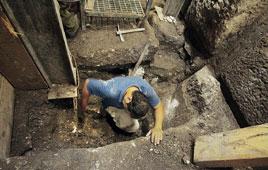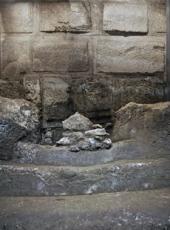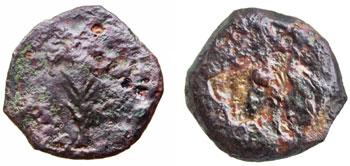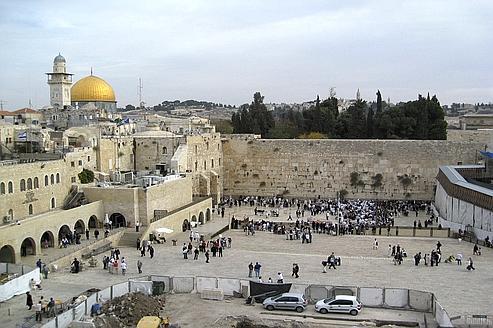Building the Western Wall: Herod began it but didn't finish it
Source - http://www.mfa.gov.il/MFA/History/Early+History+-+Archaeology/Building_Western_Wall_23-Nov-2011.htm
A ritual bath exposed beneath the Western Wall of the Temple Mount in Jerusalem shows that the construction of that wall was not completed during King Herod's lifetime.

The excavations at the Western Wall, August 2011 (Photo courtesy Israel Antiquities Authority)
Professor Ronny Reich of the University of Haifa and Eli Shukron of the Israel Antiquities Authority: A ritual bath exposed beneath the Western Wall of the Temple Mount shows that the construction of that wall was not completed during King Herod's lifetime.
Who built the Temple Mount walls? Every tour guide and every student grounded in the history of Jerusalem will immediately reply that it was Herod. However, in the archaeological excavations alongside the ancient drainage channel of Jerusalem a very old ritual bath (miqwe) was recently discovered that challenges the conventional archaeological perception which regards Herod as being solely responsible for its construction.
Recently, reinforcement and maintenance measures were implemented in the pavement of Jerusalem's main street from 2,000 years ago, used by pilgrims when they went up to the Temple Mount. This was done as part of the project to re-expose the drainage channel that passes beneath the street, running from the Siloam Pool in the City of David to the Jerusalem Archaeological Garden near the Western Wall. The excavations at the site are being conducted on behalf of the Israel Antiquities Authority, in cooperation with Nature and Parks Authority and the East Jerusalem Development Corporation, and are underwritten by the Ir David foundation. The excavations are directed by archaeologist Eli Shukron of the Israel Antiquities Authority, with assistance from Professor Ronny Reich of the University of Haifa.

The first course of the wall resting on the bedrock. (Photo: Vladimir Naykhin)
In an excavation beneath the paved street near Robinson's Arch, sections of the Western Wall's foundation were revealed that is set on the bedrock - which is also the western foundation of Robinson's Arch - an enormous arch that bore a staircase that led from Jerusalem's main street to the entrance of the Temple Mount compound.
According to Professor Reich, "It became apparent during the course of the work that there are rock-hewn remains of different installations on the natural bedrock, including cisterns, ritual baths and cellars. These belonged to the dwellings of a residential neighborhood that existed there before King Herod decided to enlarge the Temple Mount compound. The Jewish historian Josephus, a contemporary of that period, writes that Herod embarked on the project of enlarging the compound in the eighteenth year of his reign (that is in 22 BCE) and described it as "the largest project the world has ever heard of".
When it was decided to expand the compound, the area was confiscated and the walls of the buildings were demolished down to the bedrock. The rock-cut installations were filled with earth and stones so as to be able to build on them. When the locations of the Temple Mount corners were determined and work was begun setting the first course of stone in place, it became apparent that one of the ritual baths was situated directly in line with the Western Wall. The builders filled in the bath with earth, placed three large flat stones on the soil and built the first course of the wall on top of this blockage.
While sifting the soil removed from inside the sealed ritual bath, three clay oil lamps were discovered of a type that was common in the first century CE. In addition, the sifting also yielded seventeen bronze coins that can be identified.

A coin of the Roman procurator Valerius Gratus, which helped in dating
the construction of Robinson's Arc (Photo courtesy Israel Antiquities Authority)
Dr. Donald Ariel, curator of the numismatic collection of the Israel Antiquities Authority, determined that the latest coins (4 in all) were struck by the Roman procurator of Judea, Valerius Gratus, in the year 17/18 CE. This means that Robinson's Arch, and possibly a longer part of the Western Wall, were constructed after this year - that is to say: at least twenty years after Herod's death (which is commonly thought to have occurred in the year 4 BCE).
This bit of archaeological information illustrates the fact that the construction of the Temple Mount walls and Robinson's Arch was an enormous project that lasted decades and was not completed during Herod's lifetime.
This dramatic find confirms Josephus' descriptions which state that it was only during the reign of King Agrippa II (Herod's great-grandson) that the work was finished, and upon its completion there were eight to ten thousand unemployed in Jerusalem.
Le Mur des Lamentations n'a pas été construit par Hérode
Laura Raim

Crédit Chris Junker/Flickr
Des découvertes archéologiques révèlent que la construction du mur occidental du Second Temple à Jérusalem a été achevée bien après la mort du célèbre roi de Judée.
Il va falloir revoir le chapitre «Mur des Lamentations » des guides touristiques d'Israël, car les origines de sa construction ne seraient pas celles que l'on croyait. Jusqu'à présent, il était admis que le site -le Mont du Temple pour les Juifs, l'Esplanade des mosquées pour les musulmans- avait été entièrement construit par Hérode, roi des Juifs.
Placé sur le trône par les Romains, Hérode règne sur la Judée de 37 avant Jésus-Christ jusqu'à sa mort, en 4 avant Jésus-Christ. Dans la tradition chrétienne, Hérode est avant tout connu pour avoir tenté de tuer l'enfant Jésus en ordonnant la mise à mort de tous les enfants de Bethlehem âgés de moins de deux ans. Grand bâtisseur, il se lance dans de grands travaux en recourant aux techniques romaines. C'est ainsi qu'on lui attribue la construction du théâtre et de l'amphithéâtre de Jérusalem, mais surtout, l'extension du Second Temple, complexe religieux juif construit au VI ème siècle avant JC sur l'emplacement du Premier Temple, détruit par Nabuchodonosor II en 587 avant Jésus-Christ. Ce que l'on appelle communément le Mur des Lamentations, principal lieu saint du judaïsme, est considéré comme étant le mur occidental restant du Second Temple, qui sert également de soubassement à l'Esplanade des mosquées, le «Noble Sanctuaire» des musulmans.
Mais des archéologues travaillant pour l'Autorité des antiquités d'Israël ont annoncé mercredi que des fouilles sous les fondations en pierre du Mur avaient permis de mettre au jour des pièces frappées par un procurateur romain de Judée vingt ans après la mort d'Hérode. Ce qui indique qu'Hérode n'a pas construit le Mur des Lamentations.
Flavius Josèphe avait raison
Les pièces de bronze ont été frappées aux alentours de 17 après Jésus-Christ par Valerius Gratus, qui précéda Ponce Pilate en tant que représentant de Rome à Jérusalem, souligne Ronny Reich, de l'Université de Haïfa, l'un des deux archéologues en charge des fouilles. Ces pièces ont été découvertes dans un bain rituel qui était antérieur à la construction du complexe du Temple d'Hérode, et avait été comblé à l'époque pour soutenir les nouveaux murs, précise Ronny Reich. Si Hérode a bien mis en route l'extension du Second Temple, les pièces montrent que la construction du Mur des Lamentations n'avait même pas commencé avant sa mort et a été probablement achevée seulement des générations plus tard.
La découverte vient confirmer un récit de Flavius Josèphe, historien romain du Ier siècle, qui après la destruction du Second Temple par Rome en 70 après Jésus-Christ, raconta que les travaux au Mont du Temple n'avaient été terminés que par le roi Agrippa II, arrière-petit-fils d'Hérode. Flavius Josèphe explique également que la fin du chantier avait laissé 18.000 travailleurs sans emploi, ce qui, selon certains historiens, est à mettre en relation avec l'éclatement de la Grande Révolte des Juifs de la province de Judée contre l'Empire romain en 66 après Jésus-Christ. Après quatre années d'affrontements, les légionnaires romains de Titus viennent à bout de l'insurrection en 70 et détruisent le Temple, marquant la fin de l'État hébreu à l'époque ancienne.
Contrôlée depuis 1967 par Israël, l'enceinte abrite la mosquée Al-Aqsa et le Dôme du Rocher, sanctuaire musulman à la coupole dorée. Ce «Noble sanctuaire», un des lieux les plus saints de l'islam, cohabite dans la douleur avec, en contrebas, le Mur des Lamentations.